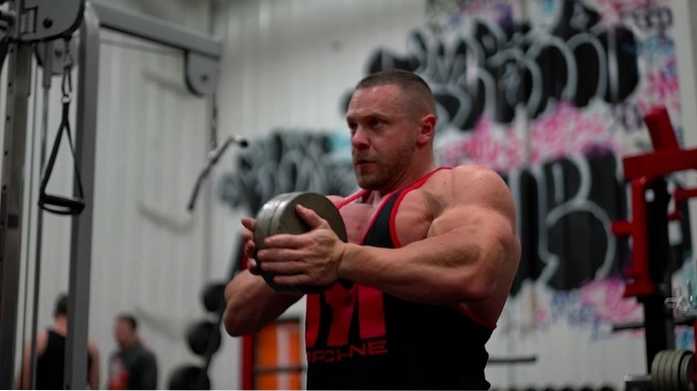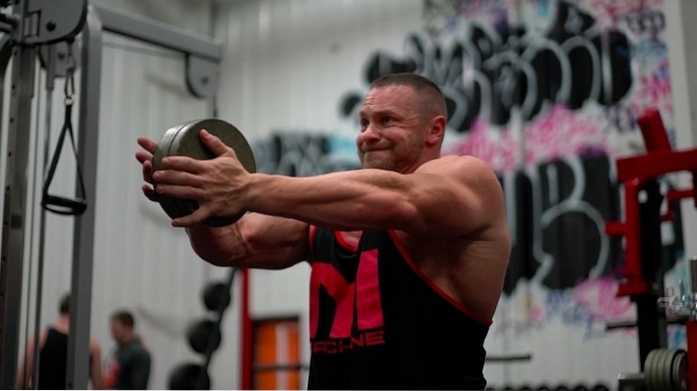
Want a Big and Strong Chest? Start Using the Svend Press In Your Training

“You need to feel the muscle work” is a saying that's common in the fitness world. Feel a muscle contract and common sense says that it's being targeted and taxed. However, an exercise that one person feels may not yield the same effect for another lifter. One move that forces this contractile feeling better than most exercises around is the Svend press, the namesake exercise of 2001 World's Strongest Man winner Svend Karlsen. That's right, a man renowned for pressing logs overhead and loading Atlas stones invented a move that requires 20 pounds - tops.
Don't be fooled. Despite its simple and admittedly unimpressive appearance, the Svend press is a small move that brings on big gains. Below, we'll take a closer look at that connection, and discuss the Svend press, a bodybuilding movement that you can incorporate into your strength program to increase chest hypertrophy.
In this Svend press exercise guide, we will cover:
- How to Do the Svend Press
- Benefits of the Svend Press
- Muscles Worked by the Svend Press
- Who Should Do the Svend Press
- Svend Press Sets, Reps, and Programming Recommendations
- Svend Press Variations
- Svend Press Alternatives
- Frequently Asked Questions
How to Do the Svend Press
The Svend Press looks like a pressing movement on its surface, but if you give it a try, you'll quickly find that the movement makes it nearly impossible to rely heavily on muscle groups other than the pecs. Below is a step-by-step guide on how to perform the Svend press.
Step 1 - Pinch the Plates

Take two 10-pound plates (or five-pound plates) and pinch them together tightly with both hands. Stand tall, keep your shoulder blades squeeze back, and hold the plates right against your chest. Be sure to press the plates together as hard as you can.
Form Tip: You should already feel the chest muscles working in the setup position.
Step 2 - Press Upwards and Inwards

Keeping the plates pressed firmly together, slowly extend your arms straight out and slightly up until your elbows are completely locked out. At this point, your chest should be contracting so hard that it's borderline painful.
Form Tip: Don't rush these. Remember that you're using at most 20 pounds, so slow and steady wins here.
Benefits of the Svend Press
Below are some of the key benefits the Svend press offers those who embark on this chest training variation.
More Chest Muscle
There's nothing worse than cranking out an awesome set of bench presses only to hit the “triceps wall,” where your pecs and shoulders barely feel fatigued but you just can't lockout that next rep. You can work around this using specialized movements (the reverse-band incline press is one of my favorites), but ultimately, the smaller triceps muscles will often be a limiting factor in pressing-heavy routines. The Svend press is a good exercise option if you are looking to increase muscle growth, not overloading the triceps or shoulders muscles.
It's Joint-Friendly
The rotator cuff's small muscles support the shoulder girdle, often fatigue far before the pecs, shoulders, and triceps - even when you're using good form. A strained rotator cuff can derail your progress in the short term, and - in serious cases - even lead to a major injury. While proper prehab movements can help to keep your rotator cuff healthy, an overabundance of pressing movements can undermine even the best mobility routines. The Svend press can be a great way to minimize strain on the shoulder joints and rotator cuff while still increasing muscle growth of the chest muscles.
Also, whenever you have the opportunity to elicit growth while using 20 pounds compared to 200, it's safe to assert that the latter is safer overall.
Improved Muscle Recruitment of the Chest
This is more relevant to bodybuilders than powerlifters, but it's important when considering a strength routine, as well. If you rely on a lot of shoulder and lat involvement in your pressing movements, this leads to an under-developed chest and a weakness in the bench press off the chest if not addressed with isolation movements. The Svend press can be used to increase muscle activation and prime the pectorals for more compound movements like the bench press.
Muscles Worked by the Svend Press
The Svend press is a pressing movement used to increase the muscle growth of the chest. Below are the primary muscles used in the Svend press movement:
Pectorals (Chest)
The pectoral muscles (chest) are the primary muscle groups involved in the force production needed to perform the Svend press. While the Svend press is limited in the range of motion when compared to a standard chest press, the chest muscles are still used (just less than in a normal bench press) to perform the lift and can get high degrees of muscle shortening and isometric tension at the top of the movement.
Who Should Do the Svend Press?
In the below section we discuss the various groups of strength, power, and fitness athletes who can benefit from integrating the Svend press within strength and accessory training programs.
Strength and Power Athletes
Strength and power athletes use the Svend press to increase chest growth while minimizing stress on the connective tissues and joints due to limited ranges of motion at the shoulder joint and lighter loading.
- Powerlifters and Strongmen/Strong Women Athletes: While bench pressing is a key movement in developing the chest and upper body strength, lifters also need to incorporate other movements that work the pecs in isolation. Various types of flies can fit that purpose, but they can also put a good amount of strain on the rotator cuff. That's where the Svend Press comes in. On its surface, the Svend Press looks like a pressing movement, but if you give it a try, you'll quickly find that the movement makes it nearly impossible to rely heavily on muscle groups other than the pecs. It's quite unique.
- Olympic Weightlifters: For most Olympic weightlifters, this has minimal carry over to the sport, or any of the competition lifts, however could be used as an accessory for general muscle growth if they cannot perform standard chest pressing.
Fitness and General Population
The Svend press can isolate the chest muscles and add additional training volume to increase muscle gain. In situations where chest pressing creates shoulder pain, you may be able to use the Svend press to increase chest growth and strength while minimizing excessive shoulder staring. Lastly, this can be a good move to do for higher reps to increase chest activation prior to or following more compound chest pressing movements.
Svend Press Sets, Reps, and Programming Recommendations
Below is the primary training goal and programming recommendation when programming the Svend presses into workouts. Note, that these are general guidelines, and by no means should be used as the only way to program the Svend press.
To Gain Muscle
The only true application for the Svend press si to better recruit the chest muscles to increase muscle mass in the chest. To build muscle mass in the chest, you can train a variety of rep ranges. For best results, add variety into your training program using rep ranges of five to 10, 10-20, or 20-30 reps for three of five sets total.
Svend Press Variations
Below are three Svend press variations that coaches and athletes can use to keep training varied and progressive.
Dumbbell Hex Press
This is a Svend press-dumbbell bench press hybrid. You lay back on a bench, press two dumbbells together (to elicit that same muscular contraction you get from the plates) and perform a dumbbell press. This is a great alternative for those who want to try and lift heavier loads using the Svend press methodology, but note that the heavier you go, the more stress you'll feel on your shoulders.
Cable Svend Press
The cable Svend press can be done similarly to the standing plate Svend press, with a slight difference. Instead of pressing plates together, you can set the pulley of a cable machine to shoulder level and perform the Svend press so that as you press outwards, away from the body, the cables are pulling the hands apart. This makes the chest continually work not only to press the hands away from you but also make sure they remind pressed together as you reach out away from your body.
Floor Press Svend Press
This variation takes all the benefits of the floor press (scapular stability, reinforces proper back tension) and combines it with the Svend press's benefits. This is a great move, too, for folks who don't fully understand how to stabilize their back or keep their shoulders back as they lower the loads.
Svend Press Alternatives
Below are three Svend press alternatives coaches and athletes can use to increase chest strength and muscle hypertrophy.
Spoto Press
The Spoto press is similar to both the floor press and the board press and is done by stopping an inch (or few) off the chest, slightly pausing, and pressing the barbell upwards towards the original position. While stopping right above the chest is not a valid lift in powerlifting, this floor press variation can strengthen the triceps, help to address sticking point weaknesses, and increase a lifter's shoulder stability and pressing balance in the press.
Dumbbell Floor Press
The dumbbell floor press is a challenging chest press variation that can be done to address muscle imbalances, increase stabilization demands, and allow for more individualization of pressing angles if an athlete has discomfort using a more fixed barbell position.
Floor Press with Chains/Bands
The floor press can be done using chains and resistance bands, similar to most other barbell pressing (and squatting/pulling) movements. Simply adding bands/chains to the sides of the barbell and placing about 60-70% of a lifter's max on the bar (if the goal is speed-strength) can help to increase overall strength and muscle, improve the rate of force development, and help lifters develop better bar path in the press.
FAQs
Can I do the Svend press with kettlebells?
Yes, you can do them with kettlebells. However, I recommend you do them with dumbbells, cables, or plates first. Kettlebells may be more awkward and won't allow for loading and/or wrist comfort as much as plates, cables, or dumbbells.
Is the Svend press better than bench presses for chest growth?
When it comes to increasing chest growth and strength, few things beat a good, heavy press. For most individuals, bench pressing is a more necessary component of a muscle growth and strength program for the chest than the Svend press, meaning you are more apt to have muscle growth doing the bench press and skipping Svend presses than the other way around.
What should you do if the Svend presses hurt my shoulders?
First off, stop doing Svend presses. They can be a tricky exercise to master, so make sure you review the proper Svend press technique. If you still cannot master technique or pain is still present, choose a Svend press alternative to see if that helps.
Featured image: Photo Courtesy of Tiger Fitness on YouTube



Nimeni nu a comentat acest articol încă.